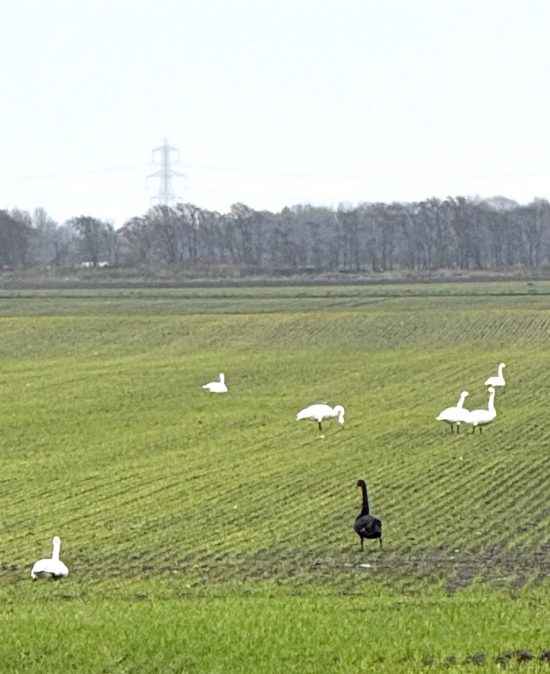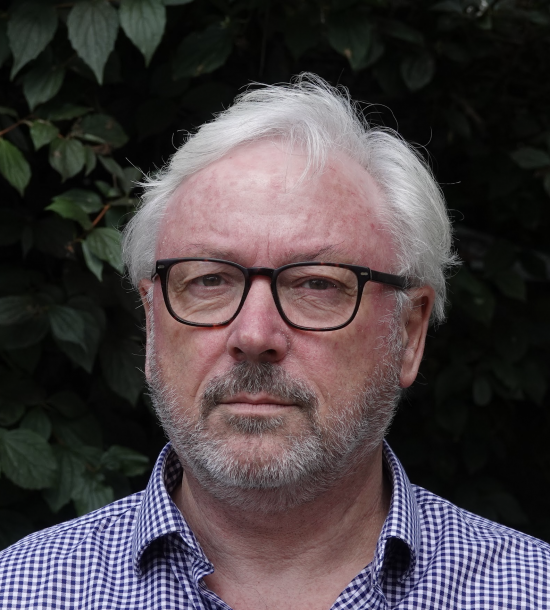I was driving to Welney to birdwatch and have a coffee yesterday, and suddenly saw a strange, large black bird in the fields to my right as I scanned the fields for whooper swans and geese, making slow progress on the Fenland roads as a result.

The bird I was looking at was a black swan. I had seen a captive bird before, but here was one out in the fields, having found other swans to mix with, who were no doubt giving it ideas on how to survive in the world, which it will need, as there is no doubt this bird is an escape from captivity. It could not have got to that field any other way.
For those whose birdwatching is based on ‘tick lists' of birds seen, this black swan does not count: escapees never do.
That is not the way in which I birdwatch. I know the birds I have seen. Mostly, I recall where and when I saw them if the bird is relatively rare. But what interests me most of all is birds in their context, and by context I mean whether and when they appear in the ‘patches' that I seek to get to know well. Welney is one of those patches. And here was a black swan in a place I call my patch - as do others. And this, then, as far as I was concerned, was a black swan moment.
Totally unexpectedly, this bird should not have been there by rights, and yet it was, and the signs were that its white whooper swan neighbours were welcoming and showing it the ropes.
If you can't see the message in that, think again, because it should be obvious. The unusual, the unexpected, the refugee, previously a migrant, appeared welcome.
They can do it. So, why can't we do the same? The black swan moment reminded me of a simple truth, which is that welcoming the stranger matters. We shouldn't forget it.
And finally, apologies for the photo: it was taken on my phone and it was bucketing with rain, but sometimes the story matters more than the detail.
Thanks for reading this post.
You can share this post on social media of your choice by clicking these icons:
There are links to this blog's glossary in the above post that explain technical terms used in it. Follow them for more explanations.
You can subscribe to this blog's daily email here.
And if you would like to support this blog you can, here:


 Buy me a coffee!
Buy me a coffee!

Brilliant post
Black Swans are the badge of western Australia. The Aboriginal people say the beak is orange because it brought fire from heaven down to the earth. We are all part of an eco-system. Swans may be regal but they are not neo-liberal
🙂
What a treat and what a sight, Richard. Thanks for sharing the picture and moment – and yes, we should never write off things. The unexpected happens – and I don’t think you can better an actual black swan to demonstrate a black swan event (I first saw them when I was about 12 on a lake in a park in Teignmouth). Continuing the birding theme, my walking partner and I routinely see small numbers of Egyptian Geese (actually related to our shelduck) mixed in with the Canada, Pink Foot and Greylag geese on the fields along the Trent. I assume you’re seeing them too?
Thanks, Ivan.
We get Egyptian geese here. They first became common in Norwich, having escaped from collections.
They are most common it seems in Cities now: London has big populations. I am not sure anyone is treating them as a threat, unlike ruddy shelduck. I saw one one recently, but they are culled to prevent cross breeding with shelduck.
Others that cross e.g. I saw a pochard / ferringous duck cross yesterday seem to present no such issue. I am not expert enough to know why.
In Dorset (pre-retirement) I lived next to the R Stour, and there was a population of swans resident. Each year we would watch our local pair as they nested on the same spot on a turn in the river (I walked or cycled over the bridge every day from home to work within 25 yds of the nest, and also often saw a kingfisher in that area) hoping their nest would not be inundated before hatching time, by the regular flood over the flood plain/water meadow).
On at least 1-2 years, the grazing flock of mute swans was joined by a pair black swans, possibly from Abbotsbury swan reserve on the coast near Chesil Beach.
https://www.abbotsburyswannery.co.uk/
Black swans were seen there in 2012.
https://www.littlepeckers.co.uk/blogs/articles/black-swans
I had a chat with two mute swans by the Cam this morning. They literally came and stood beside me – maybe a metre away. Beautiful birds. I think they wanted food, but seemd quite relaxed that I had none, and were happy to share company (which does, of course, mean to share bread, so maybe they did want feeding after all).
You say “the signs were that its white whooper swan neighbours were welcoming and showing it the ropes.”
OH dear, I’m being a bit contrarian this morning, but at Audley End a few years ago I watched a black swan being aggressively chased by a pair of white swans whenever it swam anywhere near their cygnets. This memory also seems to chime with recent events outside certain hotels..:-(
Essex, eh? I was born there, but left very quickly.
I was born there too, Richard. I left in my 20s,some 50 years ago!
But I still retain great fondness for certain parts of NE Essex
My mother’s old home territory
Maggie, there are a pair of mute swans which nest every year on the river near where I live. A couple of years ago there appeared a pair of white farm yard geese, hanging out in the same area. The swans and geese rubbed along quite nicely until the swans had cygnets when they chased the geese way. This year the geese also bred, nesting about 25 metres away from the swans. The swans killed the goslings.
Wow
They are co-existing in that same field right now
Hmmmm……..
Black swans exist for sure.
But how an earth we can equate a black swan with ‘unexpected’ events in banking and finance I find to be totally dubious. We know about greed and corruption in human nature but have chosen to give it the benefit of the doubt and make out all surprised when it happens. And then we take this magnificent creature and use it as a false analogy to cover up a darker human truth.
What do I see here?
Variety, infinite variety. A variety that human society has become more and more incapable of accommodating because apparently there are no alternatives.
Like there are black swans, there are alternatives. The focus of attack must be why we are denied them.
I like that….
What a nice thought. There is certainly a darker side to nature with the predator/prey relationship, yet animals usually get on very well with other animals and most people.
I like watching ‘The Yorkshire Vet’ which often highlights these relationships, especially the farmers’ attachment to their animals.
Ah, the road to Welney! Like a switchback as the road unfolds across the rolling fen. I like your approach to birdwatching. We like to get to know our local birds, we relish the odd incomer. We had a lone Snow Bunting at Beacon Hill last month which hung around for nearly a week and was very confiding. We resist ‘twitching ‘. It is not our goal to accumulate a life list or even a year list, although we know what is new to us. We saw our first Redwing of the season on Monday last. Perhaps our paths will cross at Welney some time.
Say hi if you see me.
I have not seen a redwing as yet. Nor a fieldfare. They can’t be long in coming.
Many years ago I went for a walk with my husband along the river from Blythburgh, in Suffolk. We saw something pink in the distance and I joked that it looked like a flamingo. We got nearer and it was a flamingo. It survived there by itself for quite a long time, through at least one winter. The locals all knew but chose to keep it quiet.
That sometimes happens.
That must have been quite a sight.
Here in Melbourne, Australia, black swans are common (they’re associated with Perth, WA, but present elsewhere), and every white swan I see seems exotic 🙂
A couple of decades ago the company I then worked for had an end of year break up barbecue in Albert Park Lake, and while sitting on the grass one of the swans approached me – fairly obviously seeking food, then when I said I didn’t have any, sat against my side. It was surprising, but quite pleasing.
🙂